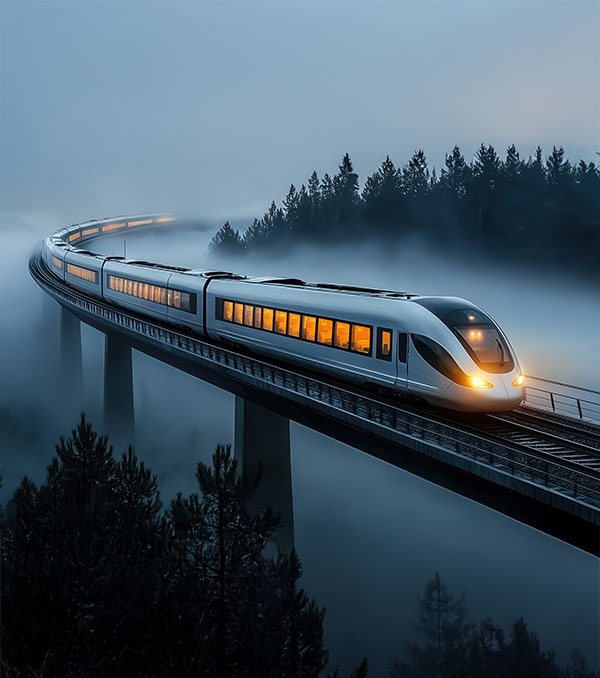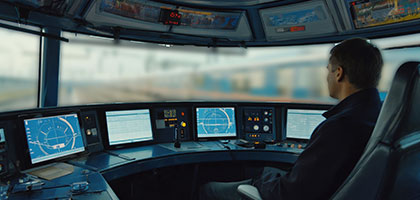

Unlocking potential of GenAI in Rail Asset Inspection and Maintenance
Reimagining Rail Asset Inspection: Harnessing GenAI & Agentic AI to elevate efficiency, safety, and intelligence.
Register Now

Integrated Digital Rail Systems
The rail industry is undergoing massive transformation, driven by the convergence of digitalization, connected technologies, and rigorous safety standards. From e-ticketing and automated train supervision to cybersecurity protocols and driverless trains, operators are leveraging innovation to build resource-efficient systems. These solutions optimize travel experiences, reduce operational costs, and ensure robust, future-ready networks for commuters worldwide.
In parallel, predictive maintenance, IoT, and big data analytics enable real-time insights into rolling stock performance. This proactive approach minimizes downtime, improves on-time performance, and fosters passenger trust. Ultimately, emerging technologies are reshaping rail systems into a seamless, secure, and passenger-centric mode of transport.
Vision-based Rail Asset Inspection Solution
Business Challenges
Rail industry stakeholders must balance cost-efficiency, increasing passenger expectations, and evolving safety demands. Aging infrastructure and legacy systems require upgrades to incorporate modern solutions like AI, cloud-based connectivity, and advanced design. Additionally, regulatory compliance, operational constraints, and the rapid pace of technology adoption create ongoing hurdles, pushing businesses to adopt holistic, integrated strategies for sustainable growth and competitive differentiation.
In Focus
Information Hub
-
What emerging trends are reshaping the rail industry?
Several digital rail trends are accelerating transformation. AI-driven solutions, IoT sensors, and data analytics power advanced surveillance, predictive maintenance, and dynamic routing. Cybersecurity measures guard against evolving threats. Simultaneously, eco-friendly practices and green technologies address sustainability demands. Furthermore, focus on passenger experience leads to better onboard services, seamless ticketing, and integrated journey planning. These trends collectively push the industry toward safer, more efficient operations.
-
How does predictive maintenance boost operational efficiency?
Predictive maintenance uses real-time data and machine learning algorithms to identify potential failures before they escalate. By monitoring critical components of rolling stock—from brakes to onboard electronics—operators can schedule repairs at optimal times, minimizing service disruptions. This lowers costs, cuts downtime, and extends equipment lifespan. In turn, passengers benefit from fewer delays, improved safety, and a more reliable travel experience.
-
What role does passenger experience play in the rail industry’s future?
In a competitive travel landscape, an engaging passenger experience is essential. Amenities such as wireless connectivity, intuitive UI/UX interfaces, and comfortable cabin environments foster brand loyalty and enhance overall satisfaction. With digitalization, operators can offer real-time journey updates, contactless ticketing, and seamless transfers. As user expectations rise, prioritizing passenger experience helps rail organizations retain ridership, generate positive word-of-mouth, and stand out among alternative transportation modes.
-
How do new digital solutions ensure safety in rail networks?
By integrating AI, Big Data, and IoT-driven sensors, modern rail systems gain immediate visibility into operations. Automated alerts detect anomalies, which can indicate technical failures or external threats. Driverless trains incorporate advanced collision avoidance, while automated train supervision minimizes human error. Robust cybersecurity protocols and continuous monitoring further safeguard infrastructure and passenger data, ensuring operators consistently uphold rigorous safety standards.
-
What is the industry outlook for rail over the next decade?
Over the next decade, the rail industry will harness digital transformation to overcome infrastructure challenges, intensify sustainability measures, and improve passenger experiences. Providers will experiment with hyperloop concepts, advanced battery technologies, and widespread AI deployment for operations and maintenance. Global urbanization and environmental concerns will further elevate rail’s importance, as reliable, low-carbon transport becomes a policy priority. Strong collaboration among stakeholders, supported by regulatory compliance, will guide these advancements.




























